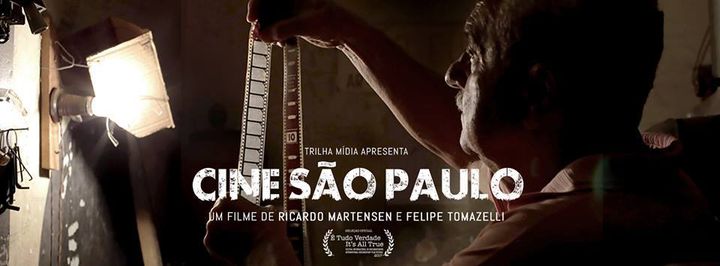
The documentary premiered at AFI Docs in Washington, D.C. in June.
‘Cinema is a part of the culture for the people of a city. If culture encounters weakness in its possibilities of expression, it’s humankind who dehumanizes itself.’ – Dom Chico, protagonist of ‘Cine São Paulo’
In a film that conjures up traces of ‘Cinema Paradiso’ in its “love letter to film,” ‘Cine São Paolo’ tells the story of an elderly man’s fight to preserve a cinema art-house in his Brazilian hometown. In this way, the self-financed and independent movie by its directors – Ricardo Martensen (who is the film’s cinematographer) and Felipe Tomazelli (its soundman) - tells a simple story: It is a life-affirming objective for the 72-year-old, Dom Chico, who seeks his own legacy. The film traces the various developmental steps, which lead to the grand reopening of the Nilson Prado Telles Cultural Center.
The film, which premiered at AFI Docs in June, recently won Best Documentary at the Biarritz Film Festival in France.
“He didn’t even know what was going to be... when we started filming,” Martensen told me. “And we changed a lot, because of the filming. And a lot of things Dom Chico wouldn’t have done if we weren’t filming. As a subject, he is a man thinking about his past, struggling with his present, [and] thinking about his future. [It’s almost as if he ruminated to himself:] ‘I want to leave a legacy. I want to leave a movie theater.’ He would do anything to achieve that.”
In the past two years, there has been a palpable fear within Brazil that stricter regulations by its government could curtail arts programs, as well as investments in technology, science and education.
“Lots of students haven’t been receiving their scholarships to help them on their research,” Virginia Bomfim, an academic and teacher in São Paulo, recently told me. “Universities can’t continue with their projects because there aren’t any funds. President Michel Temer decided to put an end to the Ministry of Culture but the society decided to stand up to it. So he was obliged to re-create it.”
Bomfim says that Brazil’s cultural centers could be adversely harmed because of an overall disinterest of the government to preserve its artistic heritage. “I guess museums could be affected. It’ll be more difficult to get money to produce movies that’ll make directors beg for investment.”
In “Cine São Paulo,” there is a moment when Dom Chico nostalgically recalls memories from the old art-house, which he inherited from his father. It was when two seminal films - David Lean’s ‘Ben Hur’ and Alfred Hitchcock’s ‘The Man Who Knew Too Much’ - were shown there. In one scene, as he describes the “Que Sera, Sera” Doris Day singing sequence from the Hitchcock film, the directors cut to the scene itself. In this way, Martensen and Tomazelli’s film is a celebration of the medium itself.
Why did Cine São Paulo deteriorate?
“VCRs led to the closing of the theater – the city bought it,” Dom Chico explains to the audience early on in the documentary. “It was declared dead several times... From 1963, 1964 on, we had TV. And then began the decline. Until 1975 when, my dad rented the movie theater to a company from Botucatu. So his company was finished in 1975. Five years later, the other company was no longer interested in it,” he says.
Oft-times the camera shows a lonely, even despondent, protagonist sweeping the floor or installing a light bulb; in his quest to renovate this once famed theater. He is always wearing shorts and slippers. He fears something may short circuit at any moment, and his expressive fears are palpable on his face. Dom Chico sometimes sounds wistful and hopeful, but other times his voice quivers, and behaves rather exasperated.
Dom Chico can also be ornery, even admonishing the two-man film crew. In one scene, he tells Martensen and Tomazelli that they were too intrusive with their filming after an inspections’ officer makes a routine check for potential safety hazards at the theater. The officer tells him that additional precautions are needed, like the use of fire retardant varnish, in order for the space to be approved by the city.
“He was visibly uncomfortable,” says Dom Chico. “And the microphone was on him. I imagine [I would be] if I was in his shoes… I wouldn’t have liked it. Especially without know what it was about.”
“You think our presence made it worse?”
“I think he was offended. We could have finished on Friday. Now it’s up in the air… Because your goal is to make the movie. And my goal is to open the movie theater. And our common goal is the movie and the movie theater. So because of your goal, which was the making the movie, my goal got much harder. So our common goal was lost in all of this.”
Such are the travails of preserving an antique movie art house, like Cine São Paulo. Such are also the pains of making a low budget movie about an occasionally temperamental protagonist.
The music in ‘Cine São Paulo’ is often enchanting, even wistful, reminding me of ‘Cinema Paradiso,’ but also akin to Chuck Workman’s ‘The Source,’ the authoritative documentary on the Beat generation. Like that film, the prevailing motif concerns the immortalization of the imaginative spirit, and the need to preserve culture so it does not plummet to the dustbin of history, or to “the depths of the thickets,” to quote Samuel Beckett.
I very much liked the picture. I admired how Martensen and Tomazelli consciously only shot within the confines of the theater. It may appear claustrophobic at times, but it’s purposeful in showing the protagonist doggedness, and stylistically, it fits the narrative.
“It wasn’t working shooting outside – so we decided to shoot everything inside the movie theater because on one hand, it’s his words; it’s a window to his world, the movies,” Tomazelli told me in June. “He’s also [like] a prisoner who is stuck in this place… The idea of the film is to maintain that he is somehow trapped with his thoughts and memories.”
The conception to make a film of Dom Chico’s quest to refurbish Cine São Paulo took place six years ago.
“We knew this man since 2011,” said Martensen. “It was an old movie theatre. Afterwards, we discovered that this is probably the oldest movie theatre running in operation in Brazil. It’s a place that [conserves] old things. It’s a very lost place, and we knew about him... By January 2015, we were discussing the subject, brainstorming, and we reminded [ourselves] about him, and didn’t know what was going on [with the theatre]. We called him, and he said: ‘it’s good that you’re calling me now, since the movie theater is being shut down, because of safety problems,” he continued.
“It was then that we realized that we had a story, and [by] the next week, we started filming. And the filming process consisted of refurbishing the building with no money. He didn’t have money, and we didn’t have money. So it took a long time [from] January to September. We were shooting this process. [As a narrative device, we were] filming this character – Dom Chico – an old man who is getting to the last part of his life.”

The author and ‘Cine São Paulo’s’ directors Ricardo Martensen and Felipe Tomazelli.
Martensen emphasized that certain kinks still need to be worked out as “Cine São Paulo” gains wider distribution; such as coordinating with big studios, like Paramount and Universal Pictures, for official use of archival film footage, which is used in their film - for great effect.
“We have the Brazilian film archives, but it’s a self-financed, independent film,” Martensen reminded me. “What we are trying to do is to speak to the owners of Universal and Paramount… [And hope to get some of the rights to films] like ‘Ben Hur,’ ‘North by Northwest,’ and ‘The Man Who Knew Too Much’ (among others). In the end, this is a film about an old man who is thinking about his life, and thinking about the past.”
Martensen said it would currently cost about $12,000 to gain access to each of these lauded films.
“The idea of the film is for it to become a cause. There is like a movement in Brazil to have street movie theaters (or cineclubs),” Tomazelli also told me. “It’s a movie about a man passionate about movies; about a movie theater, about movie history. Cine São Paolo is more than a movie theater; it’s a cultural center [where] they also put together plays, and [other] presentations.”
How has it been received?
“People who went to see the film left feeling motivated... with the message of a person who struggles to find something meaningful in life,” said Martensen. “It reaffirms having a purpose in life. A lot of people came by and said: ‘We saw a movie about life - about a man who keeps his dream alive…’
“In ‘Cine São Paulo,’ we looked at what Dom Chico was doing, but for him - he was just living his life.”
By the film’s closing credits, I am reminded of what Martin Scorsese imparted to cineastes at the Film Foundation in 2006.
“Film stocks are fragile. So it needs to be preserved and protected,” Scorsese said. “We need to keep watch over it so future generations can trace this extraordinary century-long development of visual language. Images are very powerful… We have to teach young people how to use them, and at least to begin to understand how to interpret them.”
The need to preserve motion pictures, and culture within all societies, ought to be the stated goal for veritable artists the world over - something Martensen and Tomazelli certainly achieved in ‘Cine Sao Paulo.’
